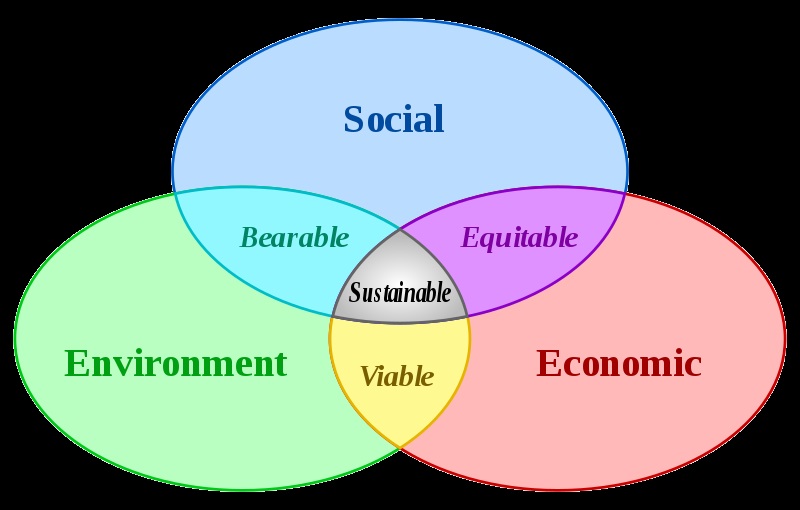Social sustainability

|
| The tripartite representation of sustainable development. Source: Wikimedia Commons |
Contents |
[edit] Introduction
Sustainability can be thought of as comprising three major components:
- Environmental (biophysical) sustainability
- Economic sustainability
- Social sustainability
The first is probably the one that most people think of when approaching sustainability. However, although all three are core components of sustainable development, it is social sustainability which seems to receive far less attention in public discourse.
There is a school of thought that rejects the tripartite classification illustrated above because it claims that all forms of sustainability have a social dimension, including ecological, economic, political and cultural sustainability. Clearly, there are several approaches in arriving at a definition of social sustainability.
Social Life, a UK-based social enterprise specialising in place-based innovation, defines social sustainability as:
“A process for creating sustainable, successful places that promote wellbeing, by understanding what people need from the places they live and work. Social sustainability combines design of the physical realm with design of the social world – infrastructure to support social and cultural life, social amenities, systems for citizen engagement, and space for people and places to evolve.”
In addition, the processes and structures developed to achieve social sustainability should meet the needs of current communities without adversely affecting the ability of future communities to meet their needs and to create thriving, healthy communities.
Elements of social sustainability can include:
- Living conditions
- Health
- Safety
- Social justice
- Social capital
- Wellness
- Community development
- Community resilience
- Diversity
- Equity
- Social support
- Fair labour practices
- Empowerment
- Work-life balance
- Community engagement
- Philanthropy,
[edit] Business
Social sustainability should be a critical part of any business, claims the UN Global Compact, because it affects the quality of a business’ relationships with stakeholders. Social sustainability is a proactive way of managing and identifying business impacts on employees, workers in the value chain, customers and local communities.
A firm’s social license to operate can depend on its efforts to achieve greater social sustainability. Companies that embrace social sustainability as part of their core business strategy tend to be cognisant of the fact that their relationships with people, communities and society are critically important. For example, a socially sustainable business will be mindful of the safety of its workforce on its premises and will ensure that both it and its employees comply with all health and safety regulations.
In contrast, a firm that oversees a system of poor social sustainability increases the risks to its brand and product quality. Consumers and the media are not generally happy when they uncover stories of workers in appalling or unsafe conditions, or being paid starvation wages. All these can damage a corporation’s brand.
Increasingly educated consumers tend to like transparent supply chains and may spend more on ‘ethical’ products that have traceable supply networks and lower environmental impacts.
[edit] Towards more socially sustainable communities
Achieving greater social sustainability can, according to the UN Global Compact, help businesses to:
- Unlock new markets.
- Improve risk management.
- Become a source of innovation for new product/service lines.
- Help attract and retain business partners.
- Raise internal morale and employee engagement.
- Improve company-community conflicts.
[edit] Related articles on Designing Buildings Wiki
- A new deal for social housing.
- Affordable housing.
- Affordable rented housing.
- Cohousing.
- Creating social value from civil engineering projects.
- Creating strong communities – measuring social sustainability in new housing development
- Gentrification.
- Help to buy.
- Housing associations.
- Housing tenure.
- Intermediate housing.
- Municipal Dreams: the rise and fall of council housing.
- Private-rented sector regulations.
- Public v private sector housing.
- Regeneration.
- Right to acquire.
- Right to buy.
- Right to rent.
- Shared equity / Partnership mortgage.
- Shared ownership.
- Social housing v affordable housing.
- Social rented housing.
- Social value act
- The full cost of poor housing.
- Town and Country Planning Act.
Featured articles and news
RTPI leader to become new CIOB Chief Executive Officer
Dr Victoria Hills MRTPI, FICE to take over after Caroline Gumble’s departure.
Social and affordable housing, a long term plan for delivery
The “Delivering a Decade of Renewal for Social and Affordable Housing” strategy sets out future path.
A change to adoptive architecture
Effects of global weather warming on architectural detailing, material choice and human interaction.
The proposed publicly owned and backed subsidiary of Homes England, to facilitate new homes.
How big is the problem and what can we do to mitigate the effects?
Overheating guidance and tools for building designers
A number of cool guides to help with the heat.
The UK's Modern Industrial Strategy: A 10 year plan
Previous consultation criticism, current key elements and general support with some persisting reservations.
Building Safety Regulator reforms
New roles, new staff and a new fast track service pave the way for a single construction regulator.
Architectural Technologist CPDs and Communications
CIAT CPD… and how you can do it!
Cooling centres and cool spaces
Managing extreme heat in cities by directing the public to places for heat stress relief and water sources.
Winter gardens: A brief history and warm variations
Extending the season with glass in different forms and terms.
Restoring Great Yarmouth's Winter Gardens
Transforming one of the least sustainable constructions imaginable.
Construction Skills Mission Board launch sector drive
Newly formed government and industry collaboration set strategy for recruiting an additional 100,000 construction workers a year.
New Architects Code comes into effect in September 2025
ARB Architects Code of Conduct and Practice available with ongoing consultation regarding guidance.
Welsh Skills Body (Medr) launches ambitious plan
The new skills body brings together funding and regulation of tertiary education and research for the devolved nation.
Paul Gandy FCIOB announced as next CIOB President
Former Tilbury Douglas CEO takes helm.
UK Infrastructure: A 10 Year Strategy. In brief with reactions
With the National Infrastructure and Service Transformation Authority (NISTA).






















